DNA Technology

- Notes
Preparing for the MCAT necessitates a solid understanding of DNA Technology, covering genetic manipulation, CRISPR, and gene therapy to gain insights into genetic engineering’s role in modern medicine.
Learning Objective
In studying ‘DNA Technology’ for the MCAT, you should develop an understanding of genetic manipulation techniques, including CRISPR, recombinant DNA, and gene cloning methods. Explore the applications of DNA technology in medicine, agriculture, and forensic science. Evaluate the ethical considerations surrounding genetic engineering and gene therapy. Additionally, understand how these biotechnological advances influence molecular diagnostics, treatment innovations, and personalized medicine. Apply this knowledge to analyze data on genetic variation, mutation impacts, and gene regulation in MCAT practice questions on genetics and molecular biology.
1. Recombinant DNA Technology
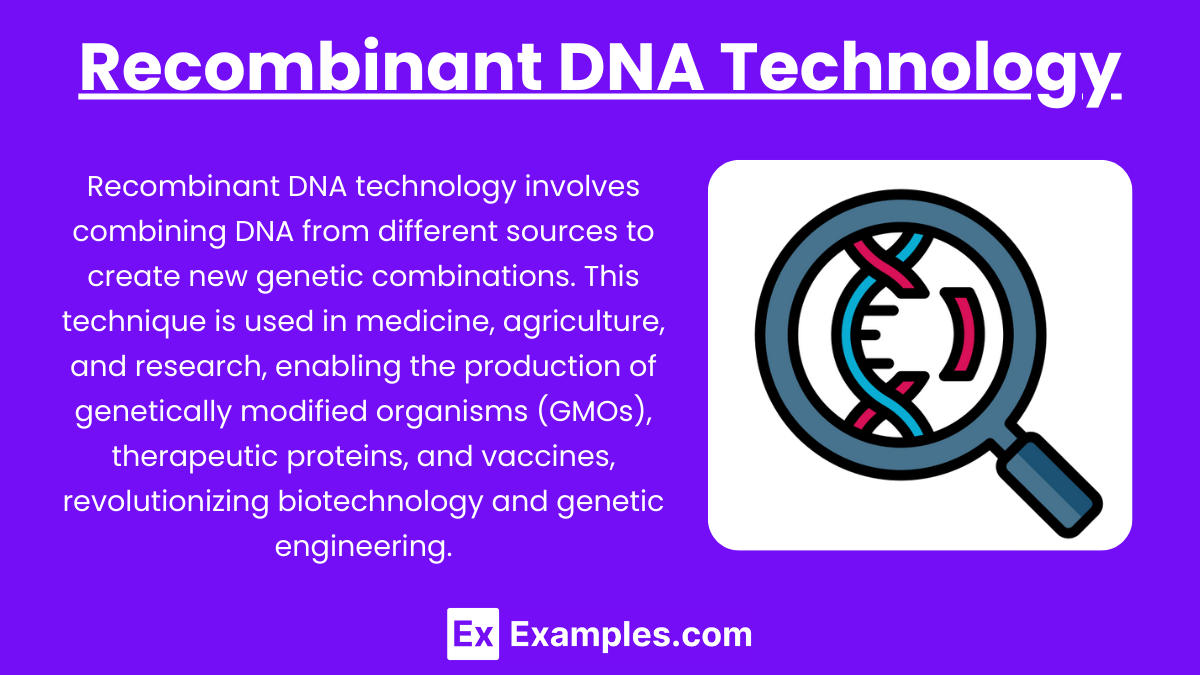
- Definition: Recombinant DNA (rDNA) technology involves combining DNA from different organisms to create new genetic combinations. This process enables scientists to clone genes, create genetically modified organisms, and produce proteins for research or medical treatments.
- Steps: Key steps include isolating the DNA of interest, cutting DNA with restriction enzymes, and using vectors (like plasmids) to insert the DNA into host cells.
- Applications: Recombinant DNA technology is used in gene therapy, the production of insulin, and the development of vaccines.
2. Polymerase Chain Reaction (PCR)
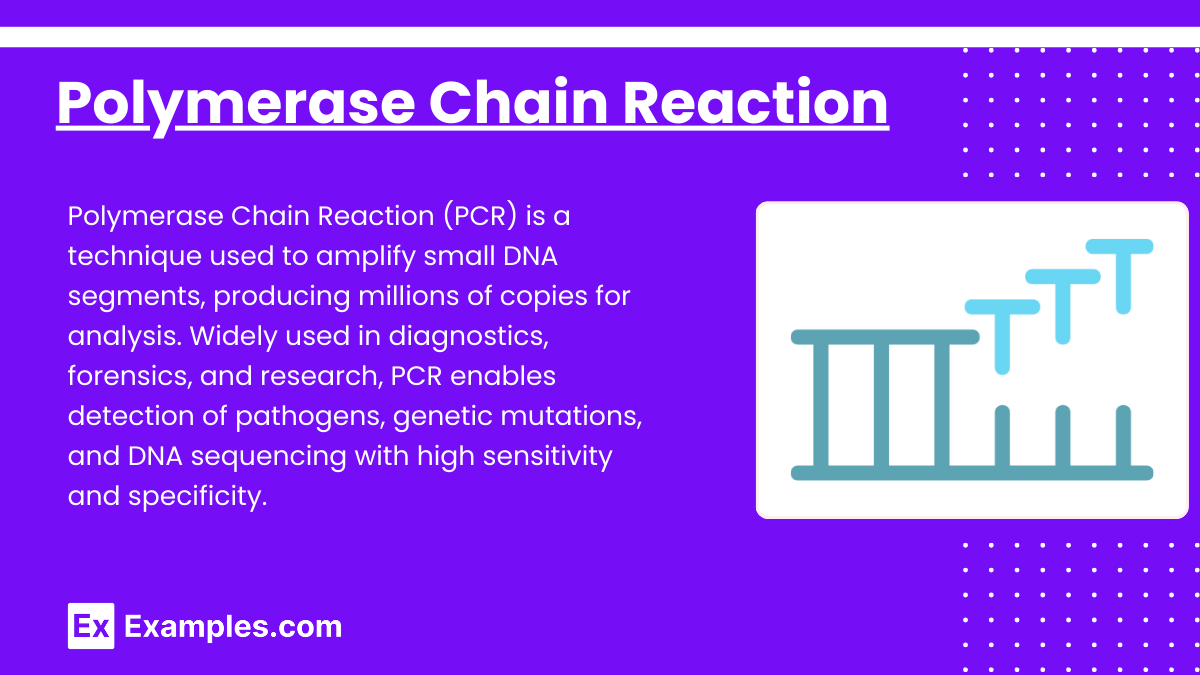
- Purpose: PCR is a technique used to amplify small segments of DNA, making millions of copies for analysis.
- Process: The three main steps are denaturation, annealing, and extension, which are repeated in cycles. This technique utilizes Taq polymerase, a heat-stable enzyme.
- Applications: PCR is widely used in genetic testing, forensic science, and diagnosing infectious diseases.
3. Gene Cloning
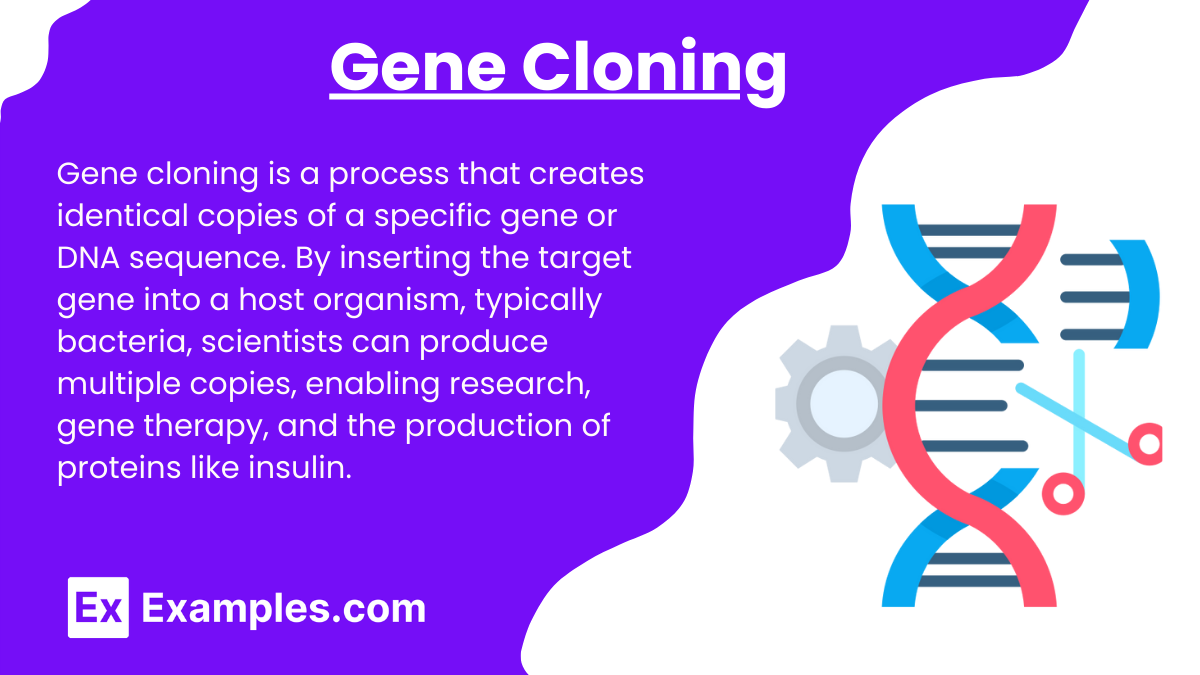
- Definition: Gene cloning involves creating identical copies of a particular gene or DNA sequence. This is achieved by inserting the gene into a vector, such as a plasmid, which is then introduced into bacteria or other host cells to replicate.
- Process: Cloning typically involves the use of restriction enzymes to cut DNA, ligase enzymes to seal DNA fragments, and transformation to introduce DNA into host cells.
- Applications: Cloning is used for protein production, studying gene functions, and developing genetically modified organisms (GMOs).
4. DNA Sequencing
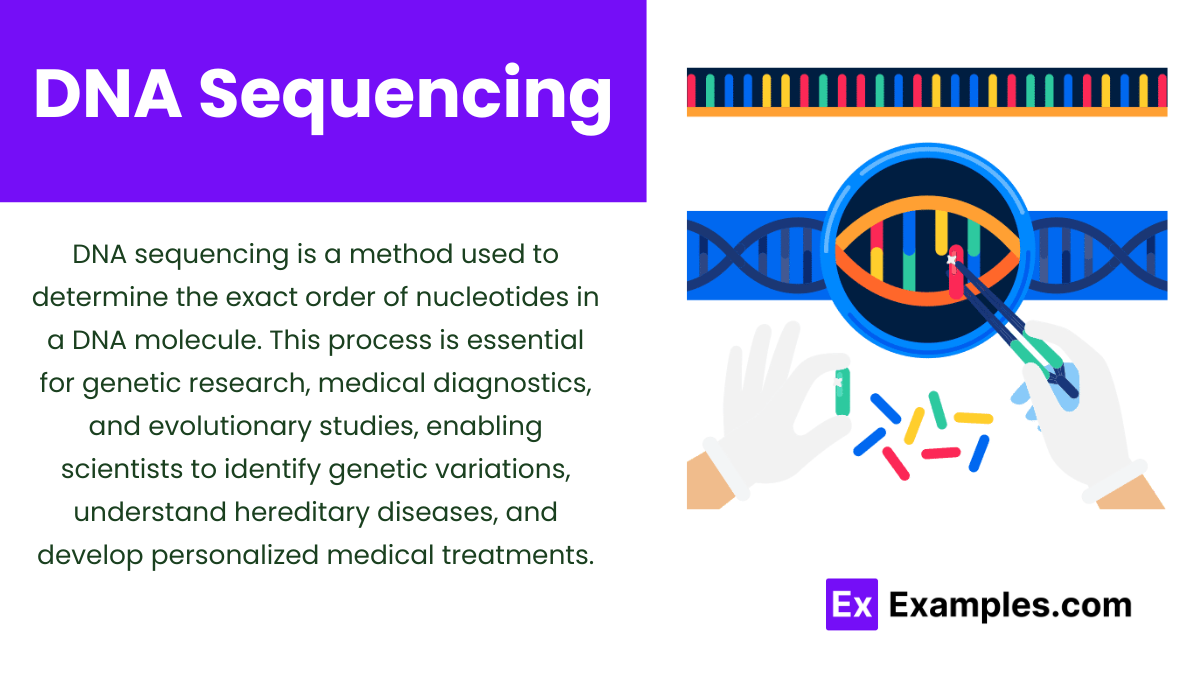
- Methods: The most common methods are Sanger sequencing and next-generation sequencing (NGS). Sanger sequencing uses chain-terminating nucleotides to determine the DNA sequence, while NGS allows for high-throughput sequencing of entire genomes.
- Applications: DNA sequencing is critical for understanding genetic diseases, personalized medicine, and evolutionary biology.
5. CRISPR-Cas9 Technology
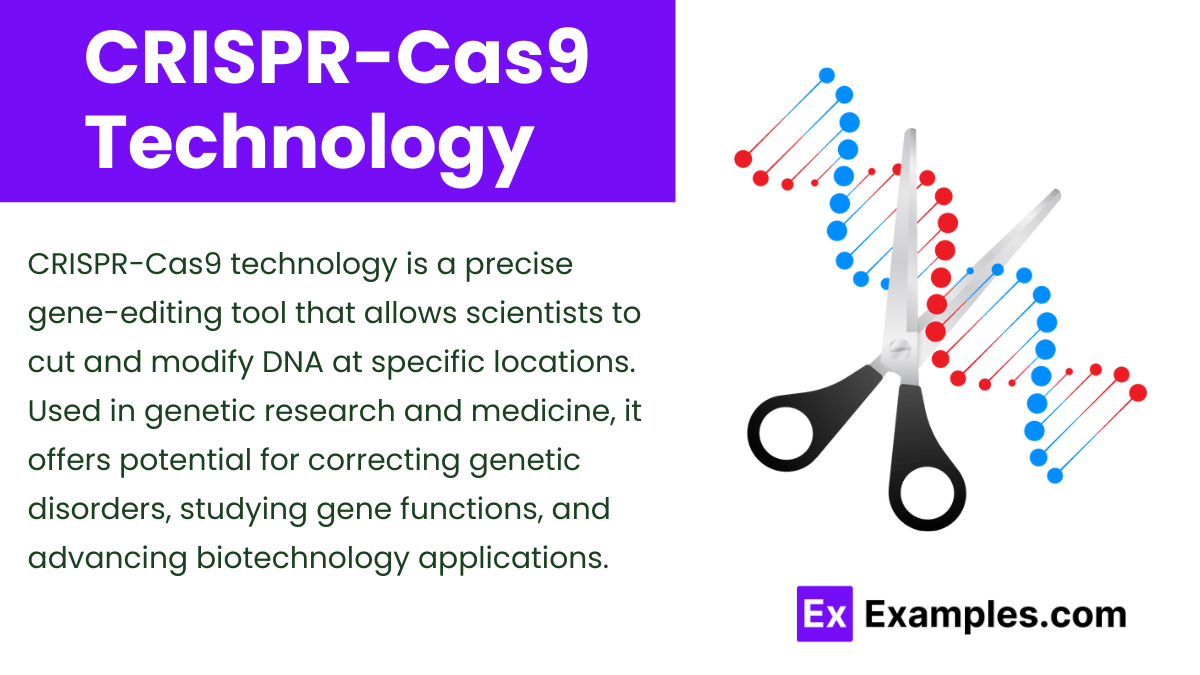
- Mechanism: CRISPR-Cas9 is a gene-editing tool that allows precise changes to DNA. It uses a guide RNA to target specific DNA sequences, and the Cas9 enzyme cuts the DNA, enabling the insertion, deletion, or modification of genes.
- Applications: CRISPR is used in gene therapy, agriculture, and research on genetic disorders. It’s also being explored for treating conditions like sickle cell anemia and certain cancers.
Examples
Example 1: Genetic Engineering Using Recombinant DNA
- Scientists combine DNA from two different organisms to create a genetically modified organism (GMO).
- For example, inserting a gene from bacteria into plants to make them resistant to pests, which enhances agricultural productivity.
Example 2: CRISPR-Cas9 Gene Editing
- CRISPR-Cas9 is a revolutionary gene-editing tool that allows precise modifications in the DNA of living organisms.
- It has been used to correct genetic defects, such as in experimental treatments for muscular dystrophy, offering potential cures for genetic diseases.
Example 3: Polymerase Chain Reaction (PCR) in Diagnostics
- PCR amplifies small segments of DNA, making it possible to detect specific genetic material from pathogens.
- During the COVID-19 pandemic, PCR testing was widely used to identify the virus in patients by amplifying viral DNA for accurate detection.
Example 4: Gene Therapy for Inherited Disorders
- Gene therapy involves inserting normal genes into cells to correct genetic mutations.
- It is used in experimental treatments for diseases like cystic fibrosis, where the faulty gene is replaced to improve lung function.
Example 5: DNA Fingerprinting in Forensic Science
- DNA fingerprinting uses unique DNA sequences to identify individuals, useful in criminal investigations.
- By comparing DNA samples from crime scenes with those of suspects, investigators can establish or exclude connections to criminal activity.
Practice Questions
Question 1:
What is the primary purpose of CRISPR-Cas9 technology in genetic research?
A) To amplify DNA segments
B) To create DNA fingerprints
C) To edit specific genes in an organism
D) To insert foreign DNA into bacteria
Answer: C) To edit specific genes in an organism
Explanation:
CRISPR-Cas9 technology is primarily used for precise gene editing, allowing researchers to modify specific genes within an organism’s DNA. This has applications in correcting genetic disorders and studying gene function.
Question 2:
Which DNA technology is commonly used to amplify small DNA samples for analysis in forensic investigations?
A) Gel electrophoresis
B) Gene therapy
C) PCR (Polymerase Chain Reaction)
D) DNA sequencing
Answer: C) PCR (Polymerase Chain Reaction)
Explanation:
PCR is widely used in forensic investigations to amplify small DNA samples, making them large enough to be analyzed. This technology is crucial in criminal cases with limited genetic material available for testing.
Question 3:
In gene therapy, what is the purpose of introducing a healthy gene into a patient’s cells?
A) To create genetically modified organisms
B) To cure infectious diseases
C) To correct defective genes causing genetic disorders
D) To prevent all types of mutations
Answer: C) To correct defective genes causing genetic disorders
Explanation:
Gene therapy involves introducing a healthy gene into a patient’s cells to replace or repair defective genes responsible for genetic disorders. This approach has potential for treating diseases like cystic fibrosis and muscular dystrophy.
Preparing for the MCAT necessitates a solid understanding of DNA Technology, covering genetic manipulation, CRISPR, and gene therapy to gain insights into genetic engineering's role in modern medicine.
Learning Objective
In studying 'DNA Technology' for the MCAT, you should develop an understanding of genetic manipulation techniques, including CRISPR, recombinant DNA, and gene cloning methods. Explore the applications of DNA technology in medicine, agriculture, and forensic science. Evaluate the ethical considerations surrounding genetic engineering and gene therapy. Additionally, understand how these biotechnological advances influence molecular diagnostics, treatment innovations, and personalized medicine. Apply this knowledge to analyze data on genetic variation, mutation impacts, and gene regulation in MCAT practice questions on genetics and molecular biology.
1. Recombinant DNA Technology

Definition: Recombinant DNA (rDNA) technology involves combining DNA from different organisms to create new genetic combinations. This process enables scientists to clone genes, create genetically modified organisms, and produce proteins for research or medical treatments.
Steps: Key steps include isolating the DNA of interest, cutting DNA with restriction enzymes, and using vectors (like plasmids) to insert the DNA into host cells.
Applications: Recombinant DNA technology is used in gene therapy, the production of insulin, and the development of vaccines.
2. Polymerase Chain Reaction (PCR)

Purpose: PCR is a technique used to amplify small segments of DNA, making millions of copies for analysis.
Process: The three main steps are denaturation, annealing, and extension, which are repeated in cycles. This technique utilizes Taq polymerase, a heat-stable enzyme.
Applications: PCR is widely used in genetic testing, forensic science, and diagnosing infectious diseases.
3. Gene Cloning

Definition: Gene cloning involves creating identical copies of a particular gene or DNA sequence. This is achieved by inserting the gene into a vector, such as a plasmid, which is then introduced into bacteria or other host cells to replicate.
Process: Cloning typically involves the use of restriction enzymes to cut DNA, ligase enzymes to seal DNA fragments, and transformation to introduce DNA into host cells.
Applications: Cloning is used for protein production, studying gene functions, and developing genetically modified organisms (GMOs).
4. DNA Sequencing

Methods: The most common methods are Sanger sequencing and next-generation sequencing (NGS). Sanger sequencing uses chain-terminating nucleotides to determine the DNA sequence, while NGS allows for high-throughput sequencing of entire genomes.
Applications: DNA sequencing is critical for understanding genetic diseases, personalized medicine, and evolutionary biology.
5. CRISPR-Cas9 Technology

Mechanism: CRISPR-Cas9 is a gene-editing tool that allows precise changes to DNA. It uses a guide RNA to target specific DNA sequences, and the Cas9 enzyme cuts the DNA, enabling the insertion, deletion, or modification of genes.
Applications: CRISPR is used in gene therapy, agriculture, and research on genetic disorders. It's also being explored for treating conditions like sickle cell anemia and certain cancers.
Examples
Example 1: Genetic Engineering Using Recombinant DNA
Scientists combine DNA from two different organisms to create a genetically modified organism (GMO).
For example, inserting a gene from bacteria into plants to make them resistant to pests, which enhances agricultural productivity.
Example 2: CRISPR-Cas9 Gene Editing
CRISPR-Cas9 is a revolutionary gene-editing tool that allows precise modifications in the DNA of living organisms.
It has been used to correct genetic defects, such as in experimental treatments for muscular dystrophy, offering potential cures for genetic diseases.
Example 3: Polymerase Chain Reaction (PCR) in Diagnostics
PCR amplifies small segments of DNA, making it possible to detect specific genetic material from pathogens.
During the COVID-19 pandemic, PCR testing was widely used to identify the virus in patients by amplifying viral DNA for accurate detection.
Example 4: Gene Therapy for Inherited Disorders
Gene therapy involves inserting normal genes into cells to correct genetic mutations.
It is used in experimental treatments for diseases like cystic fibrosis, where the faulty gene is replaced to improve lung function.
Example 5: DNA Fingerprinting in Forensic Science
DNA fingerprinting uses unique DNA sequences to identify individuals, useful in criminal investigations.
By comparing DNA samples from crime scenes with those of suspects, investigators can establish or exclude connections to criminal activity.
Practice Questions
Question 1:
What is the primary purpose of CRISPR-Cas9 technology in genetic research?
A) To amplify DNA segments
B) To create DNA fingerprints
C) To edit specific genes in an organism
D) To insert foreign DNA into bacteria
Answer: C) To edit specific genes in an organism
Explanation:
CRISPR-Cas9 technology is primarily used for precise gene editing, allowing researchers to modify specific genes within an organism's DNA. This has applications in correcting genetic disorders and studying gene function.
Question 2:
Which DNA technology is commonly used to amplify small DNA samples for analysis in forensic investigations?
A) Gel electrophoresis
B) Gene therapy
C) PCR (Polymerase Chain Reaction)
D) DNA sequencing
Answer: C) PCR (Polymerase Chain Reaction)
Explanation:
PCR is widely used in forensic investigations to amplify small DNA samples, making them large enough to be analyzed. This technology is crucial in criminal cases with limited genetic material available for testing.
Question 3:
In gene therapy, what is the purpose of introducing a healthy gene into a patient’s cells?
A) To create genetically modified organisms
B) To cure infectious diseases
C) To correct defective genes causing genetic disorders
D) To prevent all types of mutations
Answer: C) To correct defective genes causing genetic disorders
Explanation:
Gene therapy involves introducing a healthy gene into a patient’s cells to replace or repair defective genes responsible for genetic disorders. This approach has potential for treating diseases like cystic fibrosis and muscular dystrophy.
